ALDI Australia Warehouse Executive Role: Management Report Analysis
VerifiedAdded on 2020/02/24
|6
|842
|47
Report
AI Summary
This report is a comprehensive analysis of management theories and their application to the role of a Warehouse Executive at ALDI Australia. It begins with an executive summary and table of contents, followed by an introduction that outlines ALDI's organizational environment, including internal, task, and general environments. The report then delves into ALDI's business model, emphasizing sustainability and corporate culture, and its alignment with the McKinsey 7-S model for organizational analysis. The core of the report explores various management theories, including behavioral, scientific, contingency, and systems theories, highlighting their relevance in achieving efficiency and improving employee retention and productivity within the context of ALDI's operations. The conclusion summarizes the effective utilization of these theories and concepts within ALDI's business model. The report references key academic sources to support its arguments.
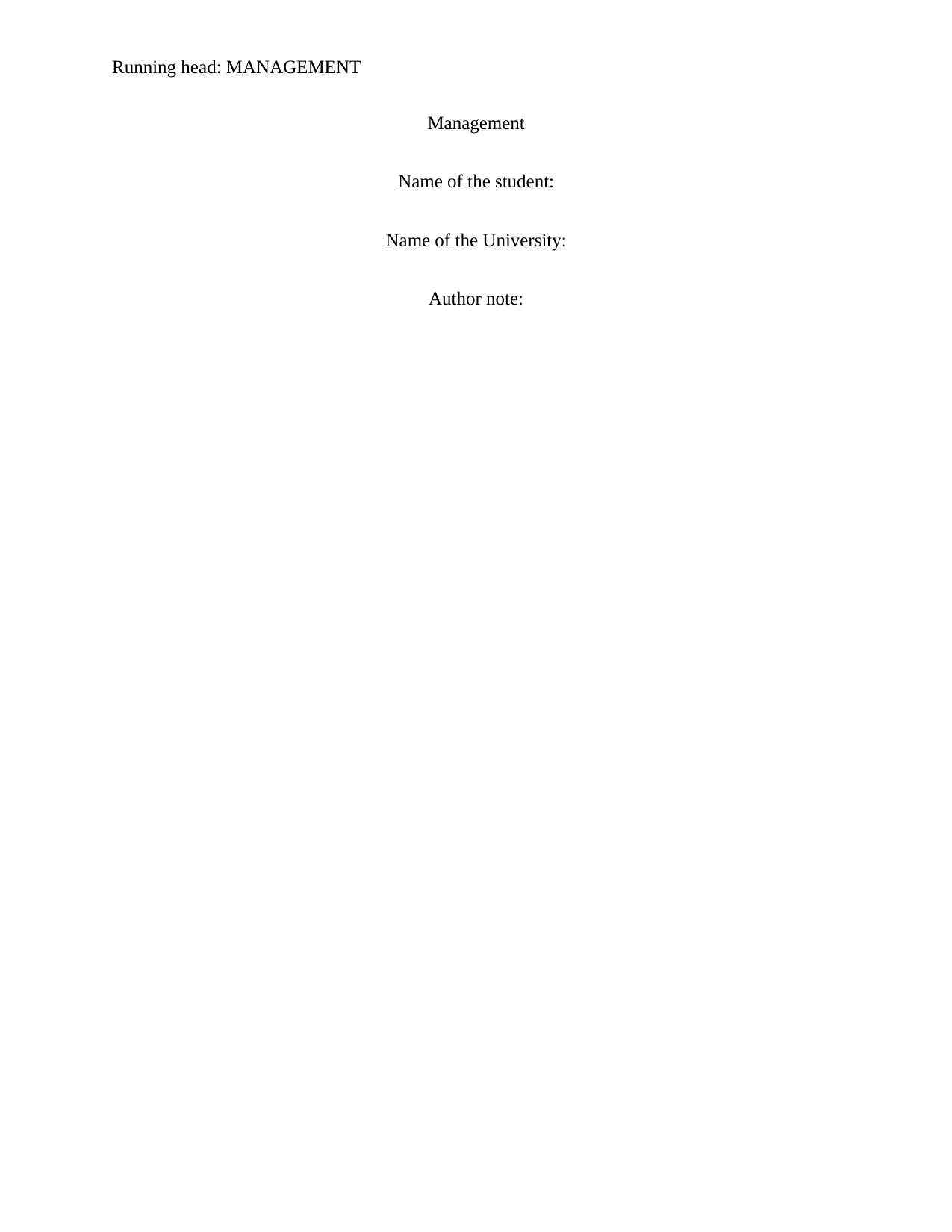
Running head: MANAGEMENT
Management
Name of the student:
Name of the University:
Author note:
Management
Name of the student:
Name of the University:
Author note:
Paraphrase This Document
Need a fresh take? Get an instant paraphrase of this document with our AI Paraphraser
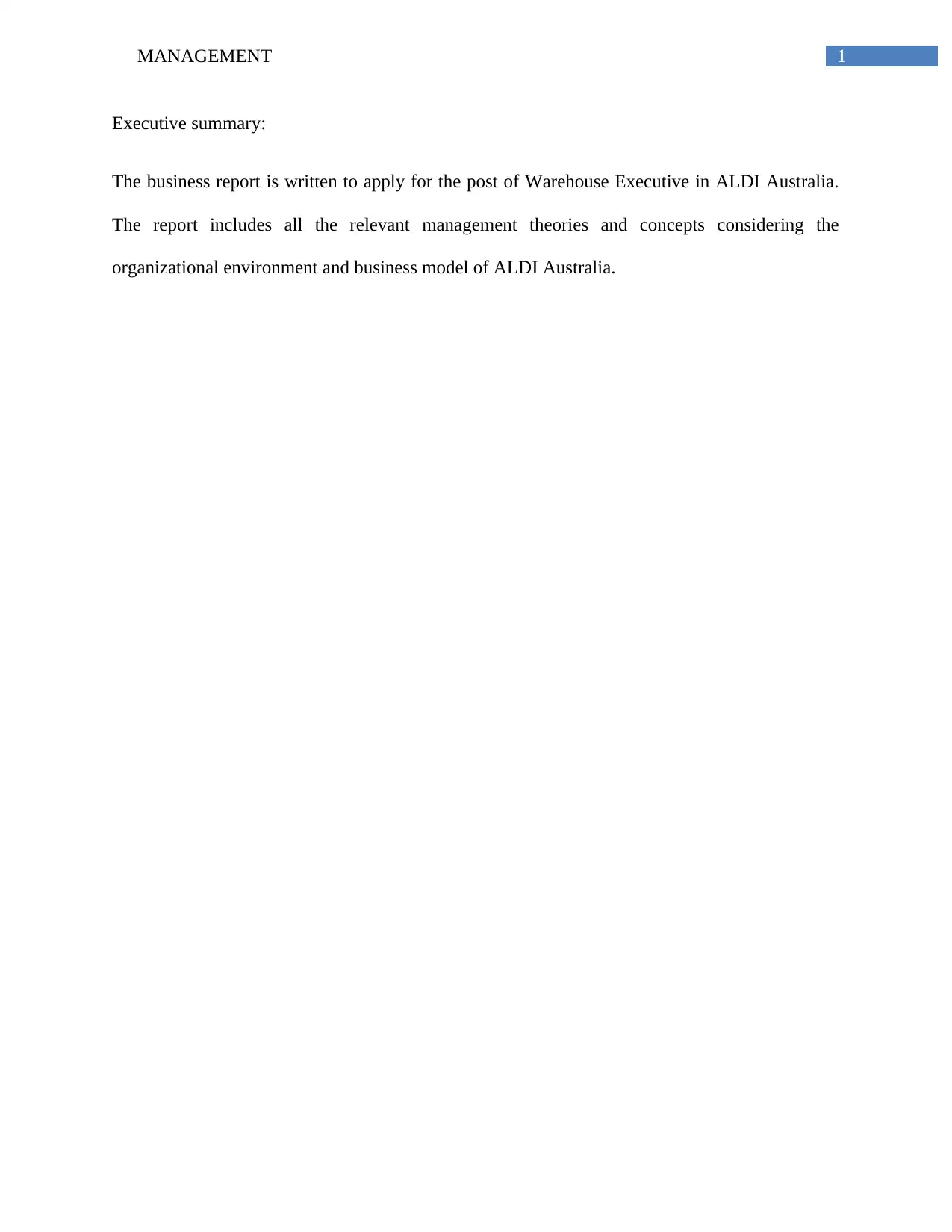
1MANAGEMENT
Executive summary:
The business report is written to apply for the post of Warehouse Executive in ALDI Australia.
The report includes all the relevant management theories and concepts considering the
organizational environment and business model of ALDI Australia.
Executive summary:
The business report is written to apply for the post of Warehouse Executive in ALDI Australia.
The report includes all the relevant management theories and concepts considering the
organizational environment and business model of ALDI Australia.
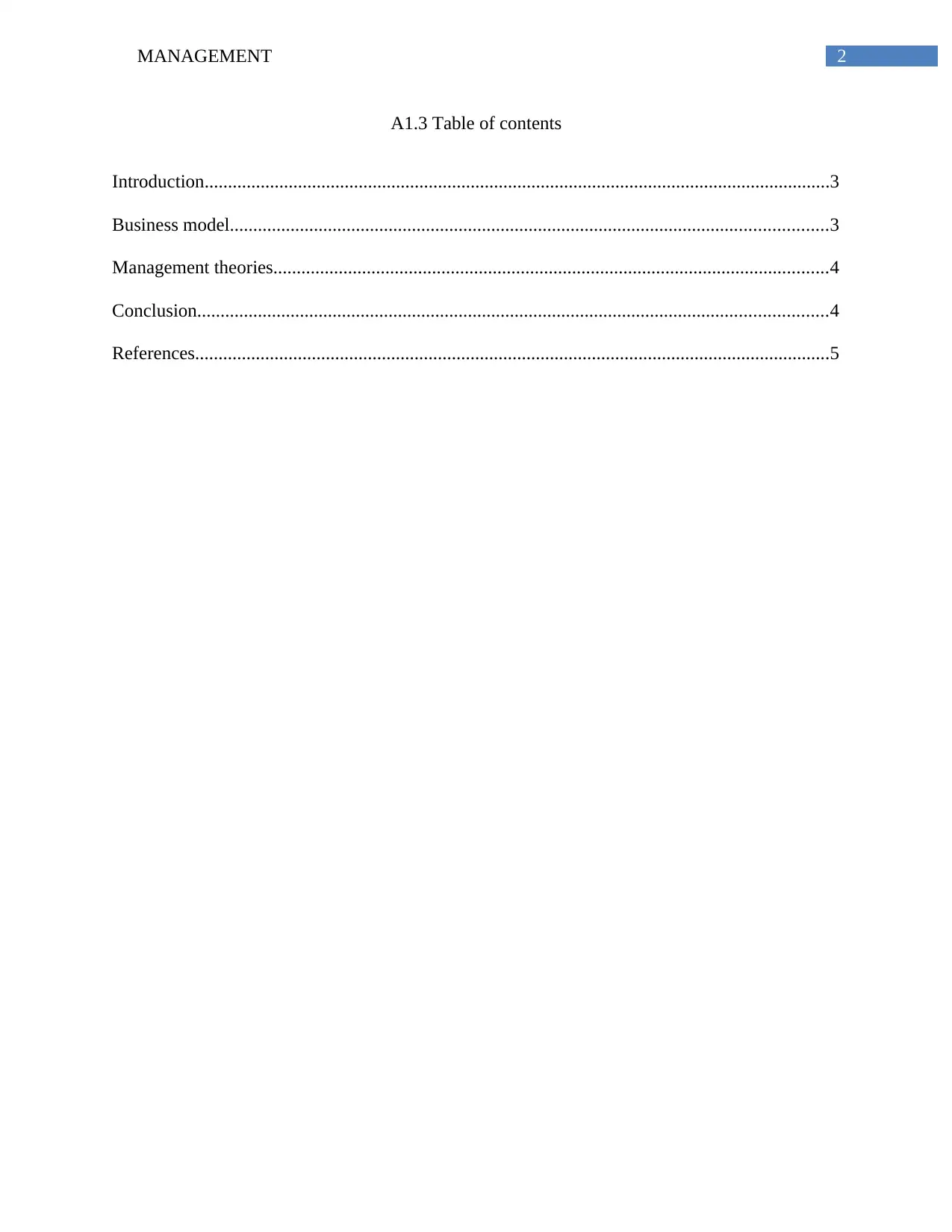
2MANAGEMENT
A1.3 Table of contents
Introduction......................................................................................................................................3
Business model................................................................................................................................3
Management theories.......................................................................................................................4
Conclusion.......................................................................................................................................4
References........................................................................................................................................5
A1.3 Table of contents
Introduction......................................................................................................................................3
Business model................................................................................................................................3
Management theories.......................................................................................................................4
Conclusion.......................................................................................................................................4
References........................................................................................................................................5
⊘ This is a preview!⊘
Do you want full access?
Subscribe today to unlock all pages.

Trusted by 1+ million students worldwide
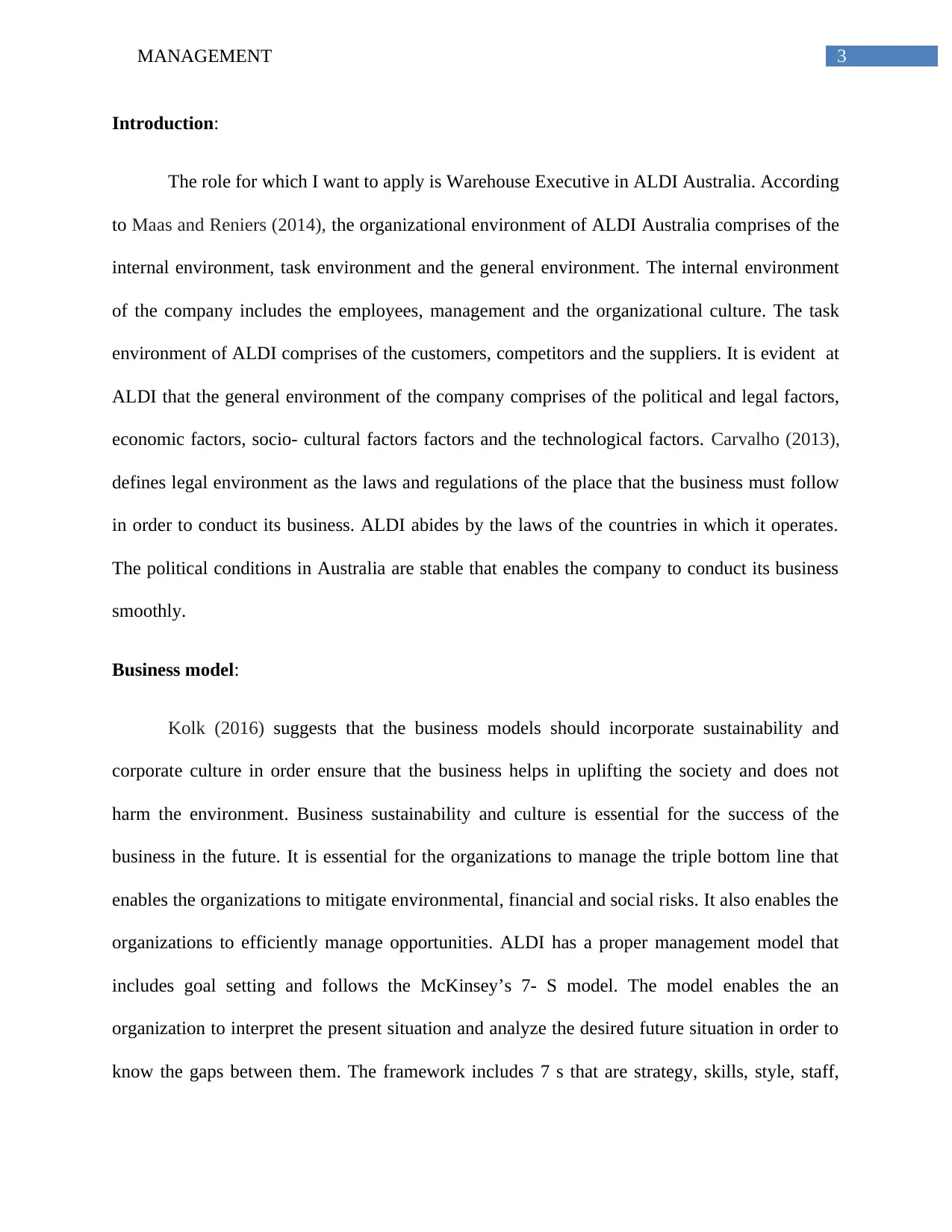
3MANAGEMENT
Introduction:
The role for which I want to apply is Warehouse Executive in ALDI Australia. According
to Maas and Reniers (2014), the organizational environment of ALDI Australia comprises of the
internal environment, task environment and the general environment. The internal environment
of the company includes the employees, management and the organizational culture. The task
environment of ALDI comprises of the customers, competitors and the suppliers. It is evident at
ALDI that the general environment of the company comprises of the political and legal factors,
economic factors, socio- cultural factors factors and the technological factors. Carvalho (2013),
defines legal environment as the laws and regulations of the place that the business must follow
in order to conduct its business. ALDI abides by the laws of the countries in which it operates.
The political conditions in Australia are stable that enables the company to conduct its business
smoothly.
Business model:
Kolk (2016) suggests that the business models should incorporate sustainability and
corporate culture in order ensure that the business helps in uplifting the society and does not
harm the environment. Business sustainability and culture is essential for the success of the
business in the future. It is essential for the organizations to manage the triple bottom line that
enables the organizations to mitigate environmental, financial and social risks. It also enables the
organizations to efficiently manage opportunities. ALDI has a proper management model that
includes goal setting and follows the McKinsey’s 7- S model. The model enables the an
organization to interpret the present situation and analyze the desired future situation in order to
know the gaps between them. The framework includes 7 s that are strategy, skills, style, staff,
Introduction:
The role for which I want to apply is Warehouse Executive in ALDI Australia. According
to Maas and Reniers (2014), the organizational environment of ALDI Australia comprises of the
internal environment, task environment and the general environment. The internal environment
of the company includes the employees, management and the organizational culture. The task
environment of ALDI comprises of the customers, competitors and the suppliers. It is evident at
ALDI that the general environment of the company comprises of the political and legal factors,
economic factors, socio- cultural factors factors and the technological factors. Carvalho (2013),
defines legal environment as the laws and regulations of the place that the business must follow
in order to conduct its business. ALDI abides by the laws of the countries in which it operates.
The political conditions in Australia are stable that enables the company to conduct its business
smoothly.
Business model:
Kolk (2016) suggests that the business models should incorporate sustainability and
corporate culture in order ensure that the business helps in uplifting the society and does not
harm the environment. Business sustainability and culture is essential for the success of the
business in the future. It is essential for the organizations to manage the triple bottom line that
enables the organizations to mitigate environmental, financial and social risks. It also enables the
organizations to efficiently manage opportunities. ALDI has a proper management model that
includes goal setting and follows the McKinsey’s 7- S model. The model enables the an
organization to interpret the present situation and analyze the desired future situation in order to
know the gaps between them. The framework includes 7 s that are strategy, skills, style, staff,
Paraphrase This Document
Need a fresh take? Get an instant paraphrase of this document with our AI Paraphraser

4MANAGEMENT
system, structure and super- ordinate goals. These elements are further divided into hard
elements and soft elements. Strategy, system and structure form the hard elements whereas skills,
staff, style and shared values form the soft elements. This model helps in improving the
efficiency and overall performance of an organization. It also enables the organizations to
implement its proposed strategies.
Management theories:
Guillén, Mayo and Korotov (2015) stated that the behavioral theory of management shall
enable the companies to achieve a higher rate of efficiency and increase the employee retention
rate. A good working environment includes cleaner surroundings, availability of basic amenities,
etc. Proper working conditions enable the employees to work more efficiently and improve the
overall productivity of an organization. The scientific management theory by Taylor states that
the organizations must ensure that they provide proper wages and salaries to the employees in
order to keep their employees motivated (Waring 2016). The contingency theory enables the
organizational managers to make decisions in accordance with the situations rather than making
a common decision for all circumstances. The systems theory enables the managers to gain a
better understanding of the workplace environment and coordinate the activities for the
accomplishment of the business objectives, goals and mission.
Conclusion:
Therefore, it can be concluded that the management theories and concepts have enabled
the organizations to improve their performance. ALDI has utilized an effective business model in
accordance with the management theories and concepts.
system, structure and super- ordinate goals. These elements are further divided into hard
elements and soft elements. Strategy, system and structure form the hard elements whereas skills,
staff, style and shared values form the soft elements. This model helps in improving the
efficiency and overall performance of an organization. It also enables the organizations to
implement its proposed strategies.
Management theories:
Guillén, Mayo and Korotov (2015) stated that the behavioral theory of management shall
enable the companies to achieve a higher rate of efficiency and increase the employee retention
rate. A good working environment includes cleaner surroundings, availability of basic amenities,
etc. Proper working conditions enable the employees to work more efficiently and improve the
overall productivity of an organization. The scientific management theory by Taylor states that
the organizations must ensure that they provide proper wages and salaries to the employees in
order to keep their employees motivated (Waring 2016). The contingency theory enables the
organizational managers to make decisions in accordance with the situations rather than making
a common decision for all circumstances. The systems theory enables the managers to gain a
better understanding of the workplace environment and coordinate the activities for the
accomplishment of the business objectives, goals and mission.
Conclusion:
Therefore, it can be concluded that the management theories and concepts have enabled
the organizations to improve their performance. ALDI has utilized an effective business model in
accordance with the management theories and concepts.
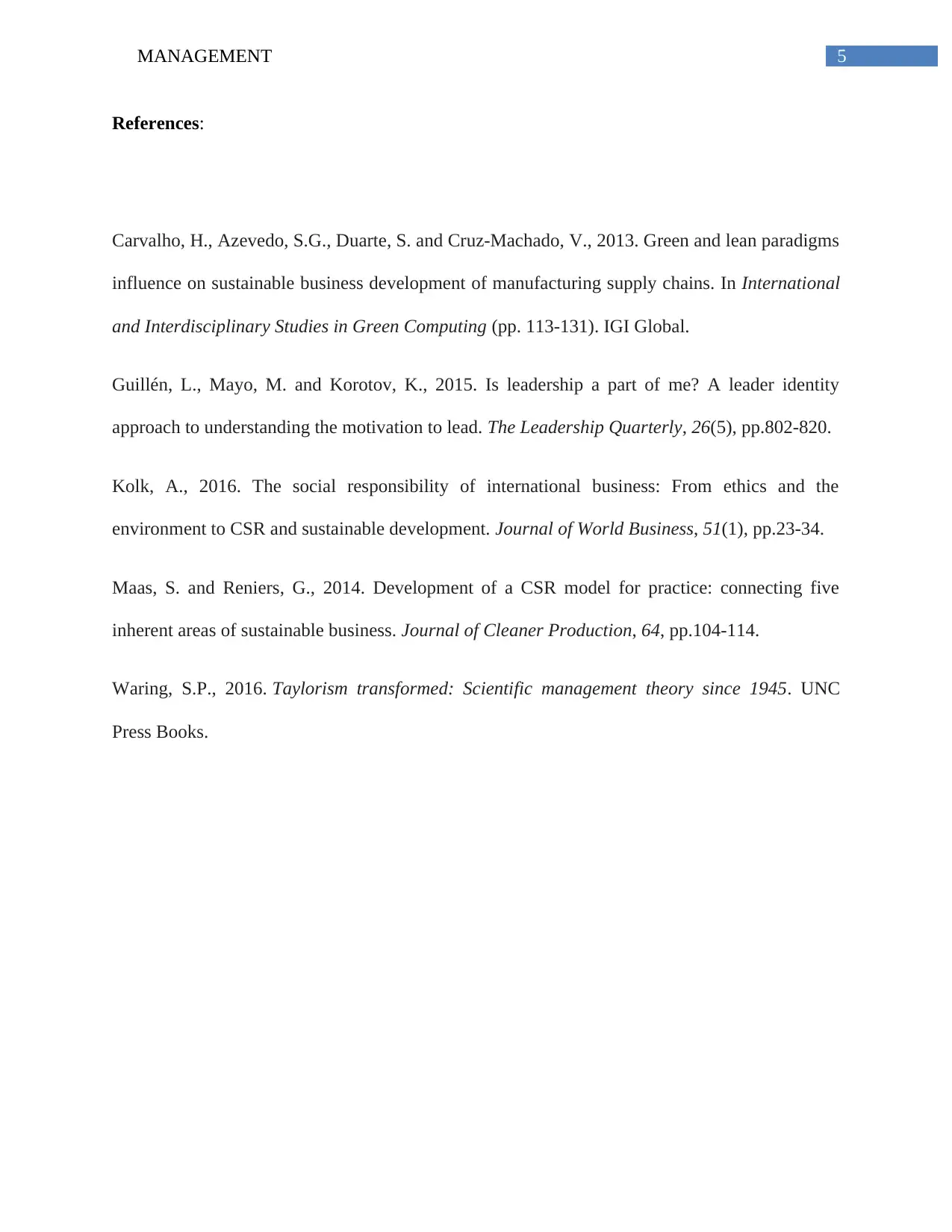
5MANAGEMENT
References:
Carvalho, H., Azevedo, S.G., Duarte, S. and Cruz-Machado, V., 2013. Green and lean paradigms
influence on sustainable business development of manufacturing supply chains. In International
and Interdisciplinary Studies in Green Computing (pp. 113-131). IGI Global.
Guillén, L., Mayo, M. and Korotov, K., 2015. Is leadership a part of me? A leader identity
approach to understanding the motivation to lead. The Leadership Quarterly, 26(5), pp.802-820.
Kolk, A., 2016. The social responsibility of international business: From ethics and the
environment to CSR and sustainable development. Journal of World Business, 51(1), pp.23-34.
Maas, S. and Reniers, G., 2014. Development of a CSR model for practice: connecting five
inherent areas of sustainable business. Journal of Cleaner Production, 64, pp.104-114.
Waring, S.P., 2016. Taylorism transformed: Scientific management theory since 1945. UNC
Press Books.
References:
Carvalho, H., Azevedo, S.G., Duarte, S. and Cruz-Machado, V., 2013. Green and lean paradigms
influence on sustainable business development of manufacturing supply chains. In International
and Interdisciplinary Studies in Green Computing (pp. 113-131). IGI Global.
Guillén, L., Mayo, M. and Korotov, K., 2015. Is leadership a part of me? A leader identity
approach to understanding the motivation to lead. The Leadership Quarterly, 26(5), pp.802-820.
Kolk, A., 2016. The social responsibility of international business: From ethics and the
environment to CSR and sustainable development. Journal of World Business, 51(1), pp.23-34.
Maas, S. and Reniers, G., 2014. Development of a CSR model for practice: connecting five
inherent areas of sustainable business. Journal of Cleaner Production, 64, pp.104-114.
Waring, S.P., 2016. Taylorism transformed: Scientific management theory since 1945. UNC
Press Books.
⊘ This is a preview!⊘
Do you want full access?
Subscribe today to unlock all pages.

Trusted by 1+ million students worldwide
1 out of 6
Related Documents
Your All-in-One AI-Powered Toolkit for Academic Success.
+13062052269
info@desklib.com
Available 24*7 on WhatsApp / Email
![[object Object]](/_next/static/media/star-bottom.7253800d.svg)
Unlock your academic potential
Copyright © 2020–2025 A2Z Services. All Rights Reserved. Developed and managed by ZUCOL.



